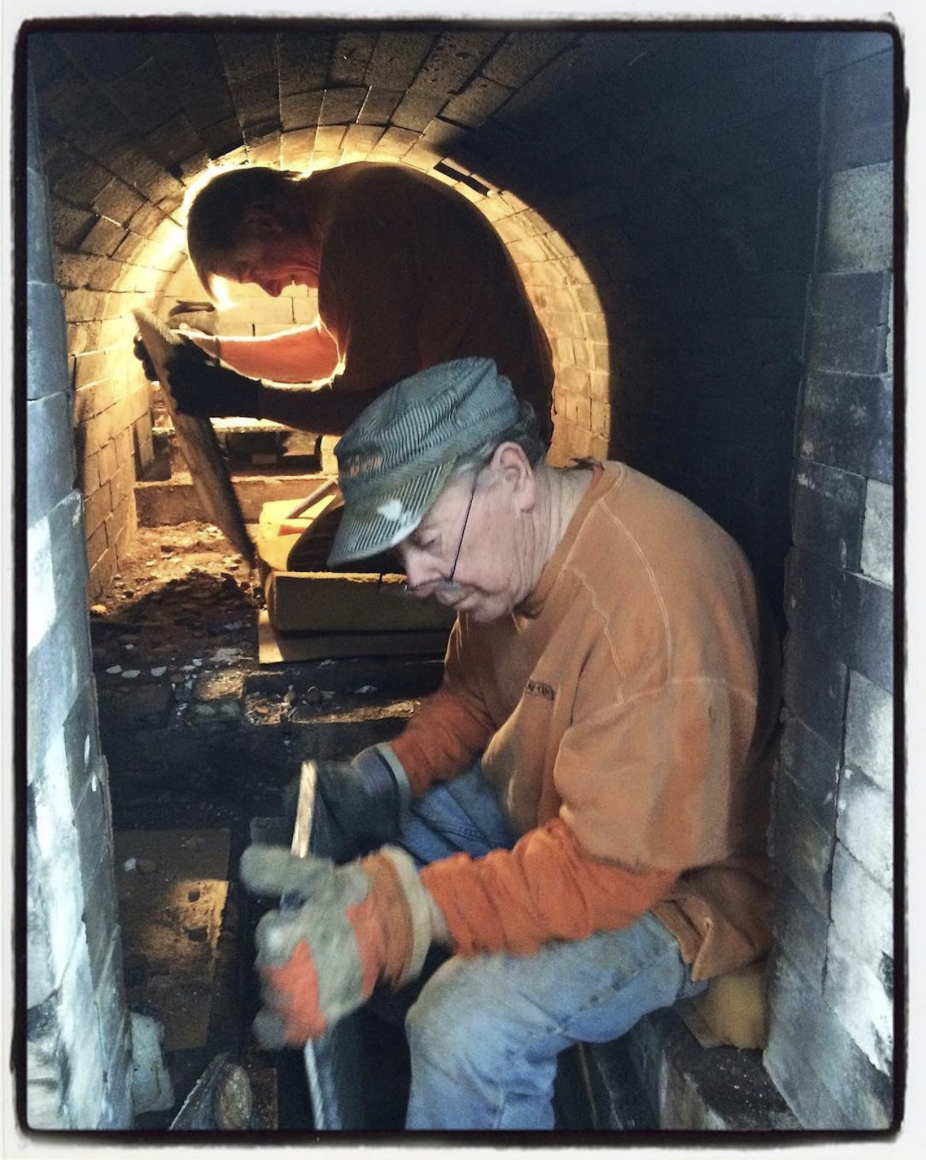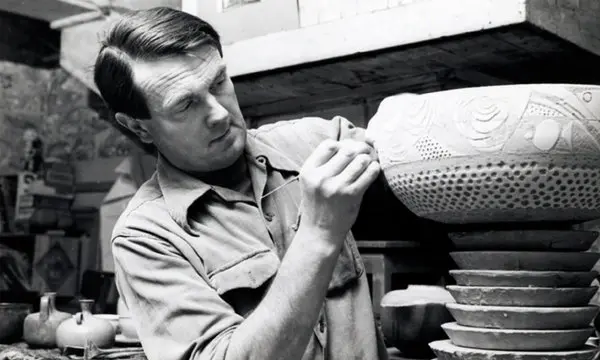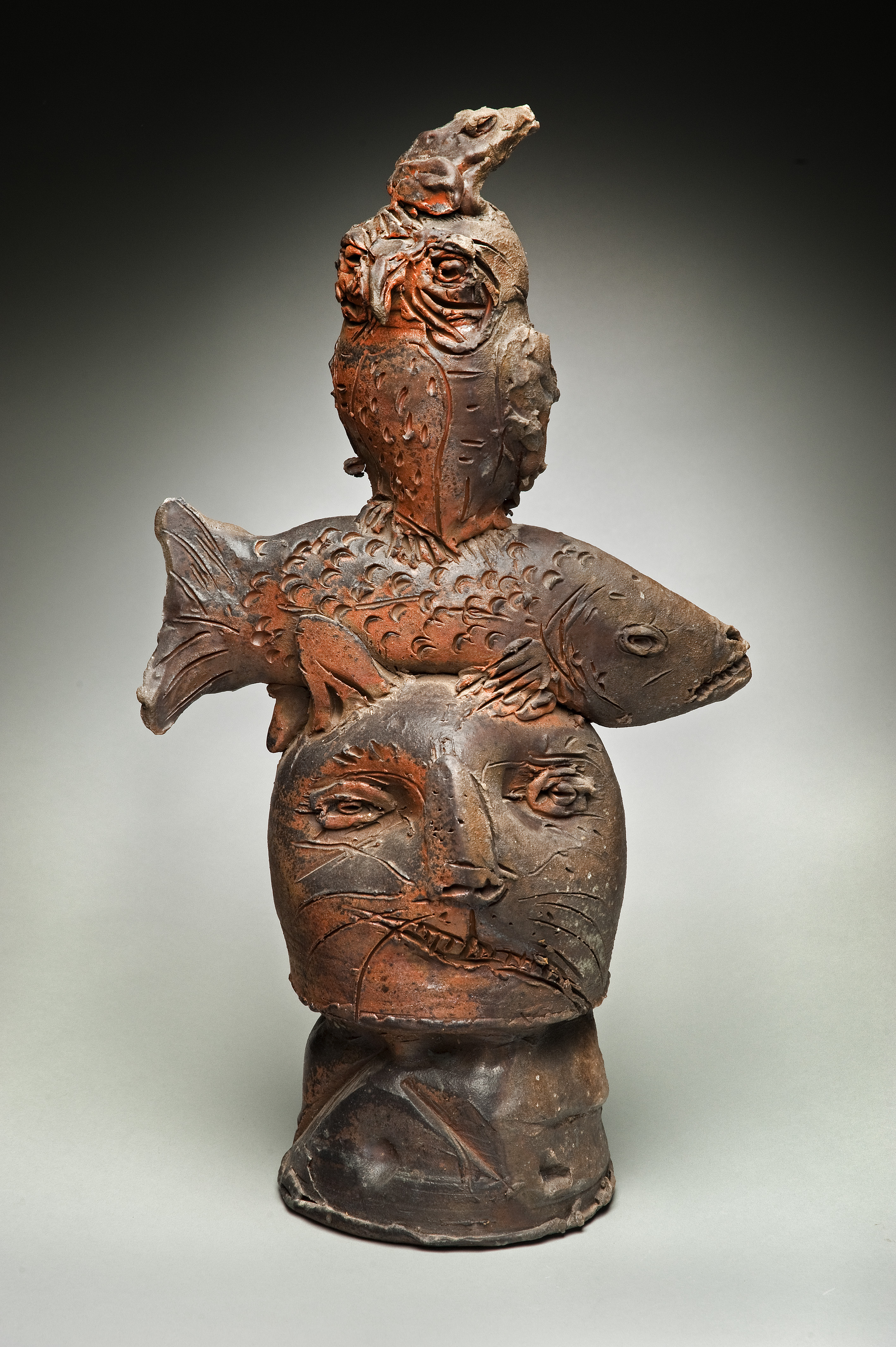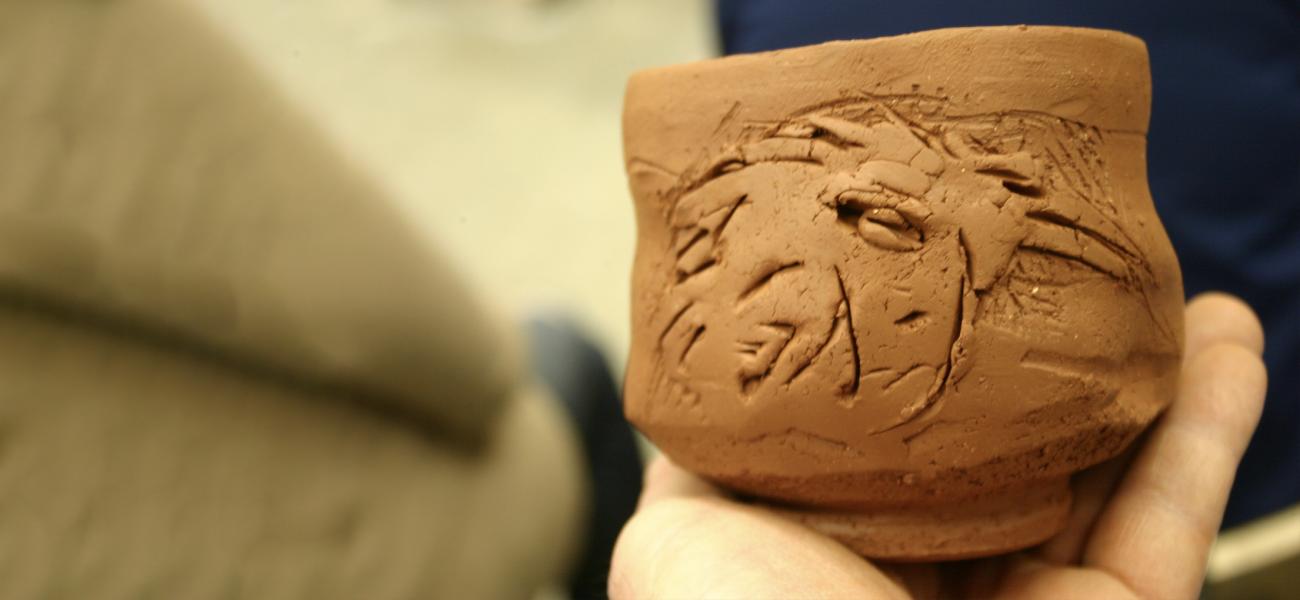Ron Meyers – Luminary in Clay
Luminary
An object, such as a celestial body, that gives light.
In astrology, one of the brightest celestial objects, such as the sun, moon, or bright planets.
A person who inspires others or achieves eminence in a field.
 I first met Ron Meyers in 1973. After graduating from college, I was hired to make pots at Mark of the Potter, near Clarkesville, Georgia. Mark of the Potter was started by John and Glen LaRowe in a converted grist mill in the northeast Georgia mountains. They bought pots wholesale from many potters in the Southeast, including Ron Meyers and Michael and Sandy Simon. Over time, they became my friends and were the beginnings of my clay community. Ron had recently taken the ceramics position at the University of Georgia and was making gas-fired reduction stoneware pots. This was a little more than a decade before he started making his iconic earthenware pots populated with his menagerie of animals. He was, from the very beginning, a kind and generous man who would always respond to your questions and share recipes for clay bodies and glazes.
I first met Ron Meyers in 1973. After graduating from college, I was hired to make pots at Mark of the Potter, near Clarkesville, Georgia. Mark of the Potter was started by John and Glen LaRowe in a converted grist mill in the northeast Georgia mountains. They bought pots wholesale from many potters in the Southeast, including Ron Meyers and Michael and Sandy Simon. Over time, they became my friends and were the beginnings of my clay community. Ron had recently taken the ceramics position at the University of Georgia and was making gas-fired reduction stoneware pots. This was a little more than a decade before he started making his iconic earthenware pots populated with his menagerie of animals. He was, from the very beginning, a kind and generous man who would always respond to your questions and share recipes for clay bodies and glazes.
In 1986, after thirteen years of making pots for a living, I applied to graduate school at the University of Georgia, and Ron was the overwhelming reason for that decision. Only in hindsight do I see what an important choice that was for me and how grateful I am to have had Ron as a mentor and friend. During his decades as a potter, he has reshaped the pottery-making landscape with his deceptively casual pots showcasing a lively cast of femmes, fishes, rabbits, frogs, and rats. I am grateful to have Ron as my mentor and friend.
Before discovering pottery, Ron was an elementary school art teacher, married with small children, and living in Gowanda, New York. Ron took a continuing education class focused on using clay with young kids at Buffalo State University while in his job as a teacher. Working with clay as a teacher led to his interest in pursuing a career in clay. He liked the material and was intrigued by being able to make something functional. After nine years of teaching, Ron applied to graduate school. Rochester Institute of Technology/School for the American Craftsman offered Ron a one-year provisional acceptance, and Ron, with Hester and their two kids, packed up and moved to Rochester in the fall of 1967.
I have talked to Ron regularly over the last couple of months about this article, and I asked him what the important things were that he wanted me to pass on. Ron, now 90 years old, said he wanted me to write about how valuable his relationship with his professor and mentor Frans Wildenhain was to his development as a potter. Frans’s influence was primary to his ceramic education, and Hobart Cowles, the other ceramics faculty at RIT, also played an important part in Ron’s ceramic education. Hobart was responsible for Ron’s understanding of the technical aspects of pottery making. It was Frans who gave him the philosophical and aesthetic foundation in clay, as well as the work ethic he has carried with him his whole professional life.

Early on, Frans offered Ron the opportunity to work for him in his home studio on weekends. This time of working together was where the relationship transformed to one of mentorship and lifelong friendship. Under Frans’s guidance, Ron went from having an inkling that pot making could become a career to finding a deep commitment and love of the material and the process. Frans was old school from the Bauhaus. Working under Frans wasn’t a love fest. He was honest, tough, and demanding. Through Frans’s mentorship, Ron discovered that pots were more than making something useful or beautiful and that graduate school was more than earning a degree.
Ron remembers that at the end of the term in his first year of graduate school, Wildenhain gave him a C. Frans said the grade reflected his hard work, growth, and improvement. However, he said it was important for Ron to compare his semester’s output to all the pots ever made over the thousands of years of human existence. Like many of Ron’s stories, told in his humorous and self-depreciating way, this was a non-confrontational way to convey a basic truth about pot making. The path to making remarkable pots will take a little longer than you think.
There is a quote by Frans from Studio Potter, Volume 8, Number 2, where he says, “Learning to make pots is like climbing a long flight of stairs. If you have long legs you sometimes can take many steps at a time, but every step knows it has been missed.” Frans, as luck would have it, was the right person for Ron, as he saw something in him that Ron did not yet see in himself.
It was in the 1980s that Ron started to change from straightforward reduction stoneware pots to his now unmistakable loose and casually thrown, painted and slipped earthenware pots using that distinctive Ocmulgee red clay. When asked what his major influences were, he stated that there were multiple sources. Ron has told me a story about a eureka moment for him, where he encountered a Japanese tea bowl at The Royal Ontario Museum and how important that discovery was for him. It altered his thinking about how you touch the clay. He also talks about the influence of some of his heroes in clay, such as Peter Voulkos, Rudy Autio, and Henry Varnum Poor. Ron’s painterly approach was informed by post-impressionist and early modernist painters, the most important being Marc Chagall. The cast of creatures that became his menagerie initially started as caricatures he made of people who he would observe and find useful to his imagination. His interest as a youngster in drawing cartoons can also be seen as a relevant input. Wildenhain insisted that Ron make pots that were more personal and meaningful to himself.
 Ron, over time, expanded his firing process to include atmospheric firing, starting with low-fire salt glazing and eventually wood firing. In the early 2000s, with the help of his good friend Chuck Hinds, Ron decided to build an anagama kiln at his studio in Athens, Georgia. At seventy, this represented a remarkable turning point in Ron’s career. There was no need to take such a departure from the way he had been successfully working. His response when asked why wood-firing was that he had fired some of his pots in Chuck’s wood kiln and saw potential in the enhanced surface qualities and that wood firing might provide a greater mystery to his work. Chuck offered to help Ron build his anagama, and that led to a later-in-life adventure and a new body of work. Wood firing was not only about the pots, but also about community. We fired the “Ratagama” over fifteen years, and those firings became an important yearly event in Ron and Hester’s lives. Over time, faculty and students from the University of Georgia, along with numerous wood-fire potters from the Southeast and beyond, became actively involved.
Ron, over time, expanded his firing process to include atmospheric firing, starting with low-fire salt glazing and eventually wood firing. In the early 2000s, with the help of his good friend Chuck Hinds, Ron decided to build an anagama kiln at his studio in Athens, Georgia. At seventy, this represented a remarkable turning point in Ron’s career. There was no need to take such a departure from the way he had been successfully working. His response when asked why wood-firing was that he had fired some of his pots in Chuck’s wood kiln and saw potential in the enhanced surface qualities and that wood firing might provide a greater mystery to his work. Chuck offered to help Ron build his anagama, and that led to a later-in-life adventure and a new body of work. Wood firing was not only about the pots, but also about community. We fired the “Ratagama” over fifteen years, and those firings became an important yearly event in Ron and Hester’s lives. Over time, faculty and students from the University of Georgia, along with numerous wood-fire potters from the Southeast and beyond, became actively involved.
Ron taught ceramics for twenty-six years. He spent six years at the University of South Carolina and twenty at the University of Georgia. Although he had a successful career as a university professor, I think his greatest impact on the world of ceramics came after stepping away from academia. Ron was best when he taught by example; making pots and doing workshops was the perfect vehicle. To be a part of one of his workshops was quite an experience. He is a marvelous storyteller with a great sense of humor. He engaged workshop participants with generosity, sharing his life and work. At one workshop, he offered to make pots for each participant and to paint any animal they requested on the pot. And he did just that. Ron was not just demonstrating and charming the audience; if the situation were right, he would put those pots in his pick-up to take them home to fire.
Ron truly loves making pots. I can see him in his studio, with a cigar in his mouth – he says he can’t decorate without one, lit or not – blissfully painting his pots. The value of Ron’s contributions to contemporary ceramics might take a while to become fully understood. When I think of all that he has done for the ceramic community, the amazing pots he has made, and his openness to sharing all that knowledge with us, I am deeply moved. When Frans talked about comparing Ron’s work to all the pots made before him, I think that a change in grade is in order.


